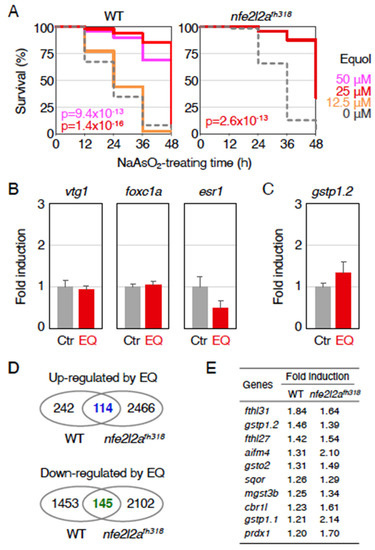FIGURE
Fig. 2
- ID
- ZDB-FIG-220516-39
- Publication
- Watanabe et al., 2022 - Soy-Derived Equol Induces Antioxidant Activity in Zebrafish in an Nrf2-Independent Manner
- Other Figures
- All Figure Page
- Back to All Figure Page
Fig. 2
|
Figure 2. Relationship between equol and the Keap1-Nrf2 pathway. (A) Antioxidant effects of equol in Nrf2-mutant larvae. Wild-type larvae (WT) or Nrf2-homozygous mutant larvae (nfe2l2afh318) at 3.5 dpf were pretreated with equol at concentrations of 0 然 (gray, dotted), 12.5 然 (orange), 25 然 (red), or 50 然 (pink). After pretreatment for 12 h, the solution was replaced with 1.9 mM (WT) or 1.4 mM (nfe2l2afh318) sodium arsenite (NaAsO2), and survival was measured every 12 h for 48 h. P values of <0.01 were considered to indicate statistical significance. (B) Expression of estrogen receptor-target genes in equol-treated larvae. Larvae at 3.5 dpf were treated with or without 25 然 equol (EQ) for 12 h, and the expression of vtg1, foxc1a, and esr1 was analyzed using qRT-PCR. The expression of untreated larvae (Ctr) was normalized to 1. Each experiment was conducted at least three times with duplicate samples. (C) Equol-induced expression of gstp1.2. Larvae at 3.5 dpf were treated with or without 25 然 equol for 12 h, and the expression of gstp1.2 was analyzed using qRT-PCR. (D) Venn diagrams showing upregulated (left) and downregulated genes (right) in 4-dpf larvae treated with 25 然 equol for 12 h identified using RNA-seq analysis. (E) List of Nrf2-target genes induced by the equol treatment in RNA-seq analysis. It should be noted that the induction of these genes was not canceled by the nfe2l2afh318 mutation.
|
Expression Data
| Genes: | |
|---|---|
| Fish: | |
| Condition: | |
| Anatomical Term: | |
| Stage: | Day 4 |
Expression Detail
Antibody Labeling
Phenotype Data
Phenotype Detail
Acknowledgments
This image is the copyrighted work of the attributed author or publisher, and
ZFIN has permission only to display this image to its users.
Additional permissions should be obtained from the applicable author or publisher of the image.
Full text @ Int. J. Mol. Sci.

